"Mars once was wet and fertile. It's now bone dry. Something bad happened on Mars. I want to know what happened on Mars so that we may prevent it from happening here on Earth." -Neil deGrasse Tyson
Oh, it's true alright, something bad did once happen on Mars. And although there isn't any real danger of that happening to Earth, a little conversation I had earlier this week made me think that it's time to tell all of you a story about our red neighbor, and why it is the way it is today.
But Mars wasn't always this way, and we know it. There are clues to that, even today. Aerial views from orbiting spacecraft show us phenomena like dried up riverbeds with oxbow bends in them,
polar ice caps and occasionally atmospheric clouds,
and recently, landers and rovers have found sedimentary structures in the terrain, silica-rich layers beneath the surface, and even hematite spheres, all evidence that water once flowed freely across the Martian surface.
But no longer, and not for more than a billion years, to the best of our knowledge. In fact, liquid water is pretty much an impossibility on Mars today! You probably remember that like all substances, water exists in the solid, liquid or gaseous phases dependent on the pressure and temperature of its environment. While all three phases are common on Earth, only two of those phases -- the solid and gaseous ones -- are possible if the pressure is below a certain threshold, occurring at the triple point of water.
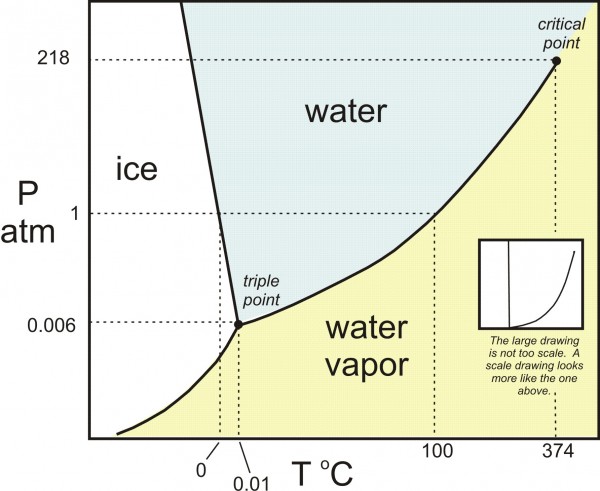 Image credit: Science Education Resource Center @ Carleton College, via http://serc.carleton.edu/.
Image credit: Science Education Resource Center @ Carleton College, via http://serc.carleton.edu/.
Unfortunately, the average atmospheric pressure on Mars is just 0.6% of what it is on Earth, placing it below the triple point of water and making the liquid phase an impossibility at all locations, excepting the depths of the deepest Martian trenches.
But the overwhelming evidence for a watery past tells us it wasn't always this way. In fact, if we go back to the early Solar System, Mars and Earth likely weren't all that different.
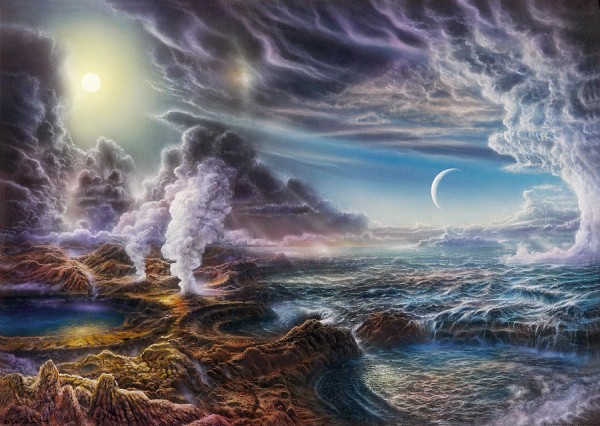 Image credit: Don Dixon, via http://fineartamerica.com/.
Image credit: Don Dixon, via http://fineartamerica.com/.
We know that our home world -- in its infancy -- was different from Earth today in a number of important ways. The atmosphere was rich with hydrogen, as the most common gases were water, ammonia, methane and hydrogen gas, all excellent at trapping heat. Even though the Sun was only about 80% as luminous as it is today, Earth still had vast oceans and liquid water throughout its surface, bombardment by asteroids and comets was many orders of magnitude more common than it is today, and all the organics necessary for complex life -- the building blocks of everything in our biosphere today -- was in place.
And to the best of our knowledge, aside from being a bit smaller and farther from the Sun, so was Mars.
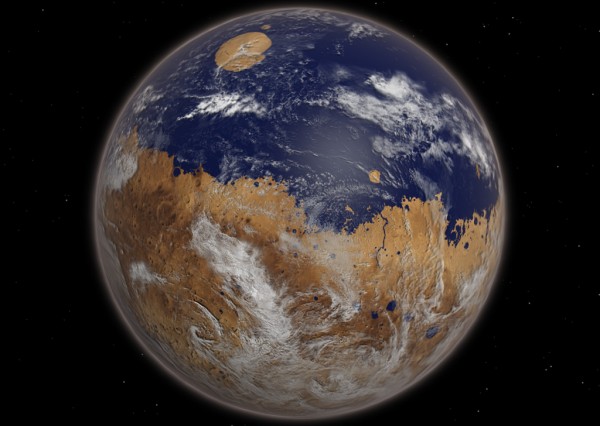 Image credit: Kevin M. Gill of flickr, http://www.flickr.com/photos/kevinmgill/.
Image credit: Kevin M. Gill of flickr, http://www.flickr.com/photos/kevinmgill/.
We know that life took hold on Earth relatively quickly, within the first few hundred million years. We also know that life was able to sustain itself on Earth; Mars, to the best of our knowledge, was not so lucky. At some point -- perhaps after the first billion or two years -- those similar conditions on Earth and Mars, those conditions that were so conducive to life, became very different. We're not certain what happened, but we have a leading (and compelling) hypothesis.
We don't think about it on a day-to-day basis, but the Sun is constantly spewing out a stream of ionized, high-energy particles in all directions. If all we had, instead of Earth, was a big rock covered in gas, that stream of particles -- the solar wind -- would strip that gas away in short order. But that doesn't happen! The main reason that the Earth still has an atmosphere that's as thick as it is is because we've got a powerful magnetic field generated in our planet's core. We typically think of the magnetic field as it is on the Earth's surface, deflecting compass needles and aiding in navigation, but the reality is that it extends far into space! As high-energy, ionized particles stream towards us, the magnetic field deflects them, and protects us mightily from the solar wind, keeping our atmosphere intact.
But the Solar System is 4.5 billion years old now, and Mars is much, much smaller than Earth.
Planets radiate heat away according to their surface area, and with a radius of just 3,390 km (or just 53% of Earth's), Mars has just 28% of Earth's surface area. But it's much lower in mass; Earth is approximately ten times as massive as Mars! Due to its much smaller mass-to-surface-area ratio, Mars has cooled much, much more quickly than Earth, all the way down to its core. At some point, the dynamic magnetic field that Mars once had (and it had one; we've already seen the relic magnetic field imprinted in Martian rock) ceased to be, and when that happened, the atmosphere of Mars was no longer protected from the solar wind.
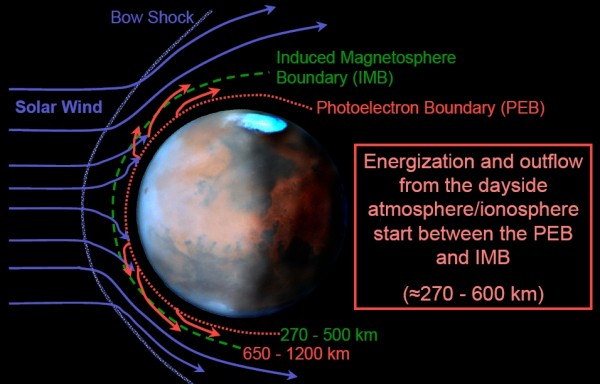 Image credit: Lundin et al., Science, Vol. 305. no. 5692, pp. 1933 - 1936, doi:10.1126/science.1101860, 2004.
Image credit: Lundin et al., Science, Vol. 305. no. 5692, pp. 1933 - 1936, doi:10.1126/science.1101860, 2004.
On a world where a thick atmosphere and liquid water ruled for maybe a billion years or more, the death of Mars' magnetic field meant that these high-energy, ionized particles would begin colliding with the particles in Mars' upper atmosphere, giving many of them enough kinetic energy to escape from the gravitational pull of the red planet! In the span of just a few million years, Mars went from a world teeming with organics, liquid water and all the building blocks of life to the desolate, barren and mostly frozen world we see today.
At least, that's the leading hypothesis. The big news from earlier this week is that the mission that's about to test that hypothesis, Mars MAVEN, was just successfully launched!
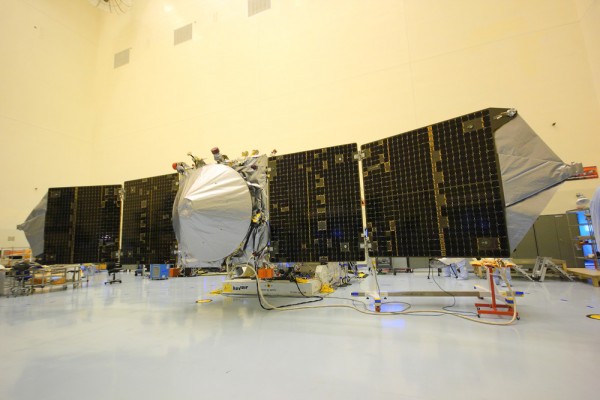 Image credit: Ken Kremer of Universe Today, via http://kenkremer.com/.
Image credit: Ken Kremer of Universe Today, via http://kenkremer.com/.
We've already got rovers on the ground, digging into the soil, returning photographs, performing analysis and exploring the terrain in unprecedented detail. But if we want to know the story of what happened to Mars' surface, that means learning what happened to Mars' atmosphere, and MAVEN is going to be the first spacecraft to attempt to figure that out by measuring what's happening to Mars' atmosphere right now.
When it reaches Mars in September of next year, MAVEN will enter an eccentric orbit around the red planet, spending most of its time a significant distance -- thousands of miles (kilometers) -- above the top of the Martian atmosphere, but once-per-orbit, dipping down into the upper atmosphere and taking data. By measuring the solar wind and the flux of atmospheric particles escaping from Mars today, it's going to give us the first hard data that will allow us to extrapolate how Mars lost its atmosphere in the first place!
One of the great things is that Mars Curiosity has similar instruments on board to the ones on MAVEN, so while MAVEN determines the atmospheric composition, elemental isotope ratios and presence-and-formation of volatiles (such as methane) in the upper atmosphere, Curiosity can do the same thing all the way down at the bottom of Mars' atmosphere. With data combined from both missions, this incredible hypothesis will be scrutinized and possibly either validated or falsified by the forthcoming data!
So when you see this cold, dry, red planet hovering in the night skies, know that it not only wasn't always that way, but that we just might be on the cusp of finding out how it came to be this way! And that's a little bit of insight into the story of Mars!

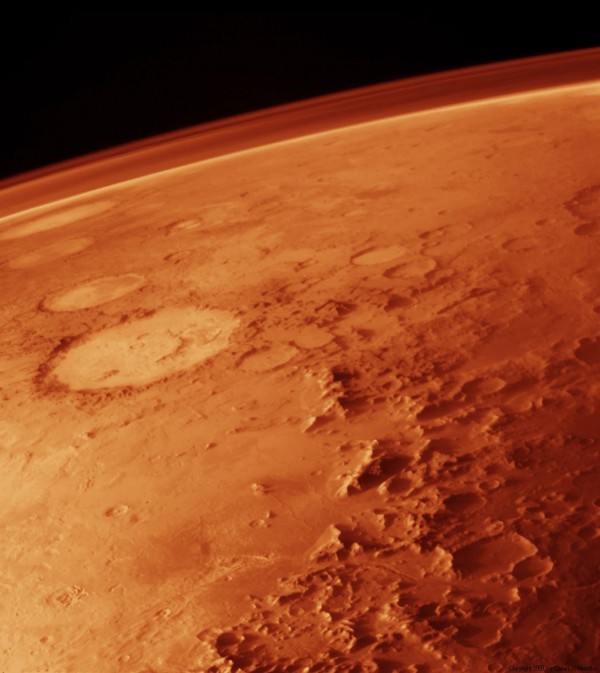


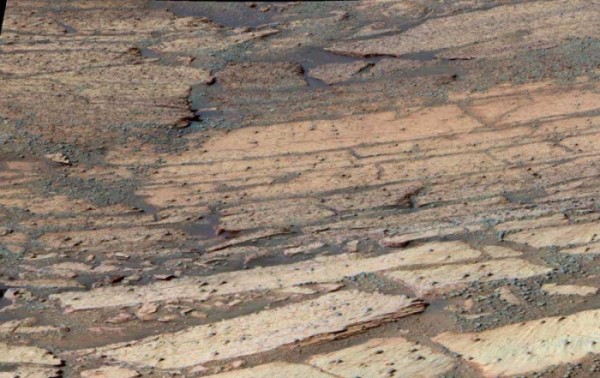
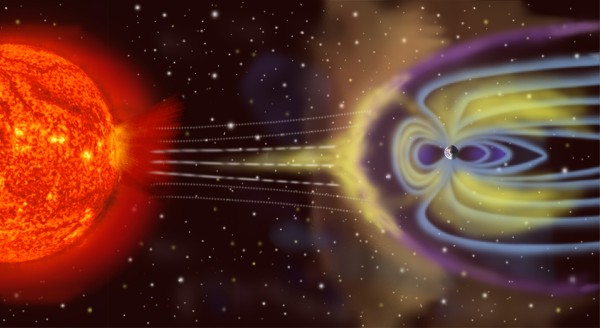
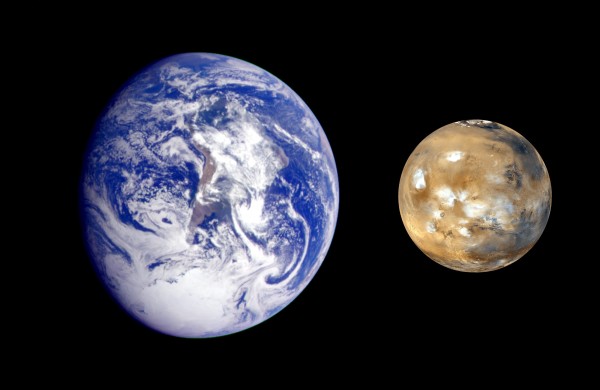
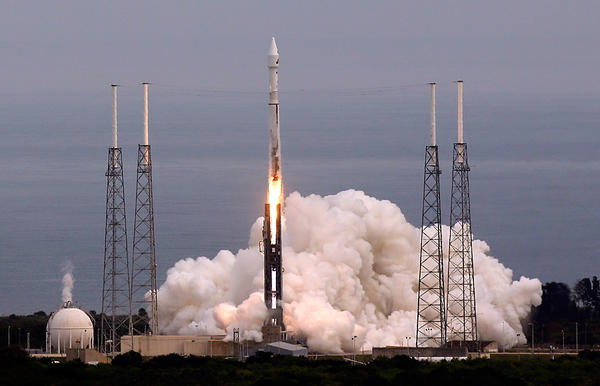
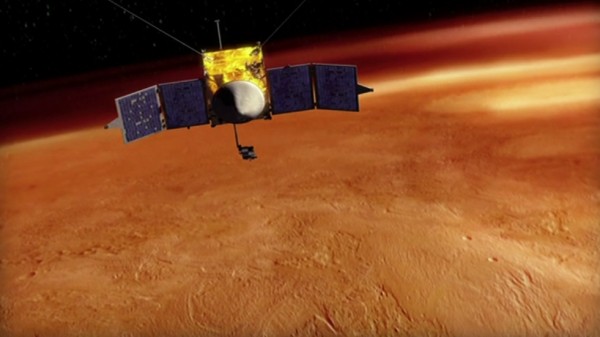


In fact, Mars' atmospheric pressure (as you quote it directly below the lovely phase diagram) is *exactly* at the triple point of water. P(tp) is 0.611 kPa; Mars' atmosphere ranges from 0.4 to 0.9 kPa, with an average (as quoted in Wikipedia) of 0.636 kPa, or just barely above P(tp).
So it is just barely possible that some place on Mars could have a higher than average pressure, and a higher than average temperature (just above 0 C), to allow surface ice to melt to liquid instead of sublimating. But not over a large area, and not for a long time.
It is a great theory, and probably true. What I don't understand is if what has just been said about Mars is true, why does Venus have an atmosphere? The force of the solar wind Venus is subjected to is far stronger than the one hitting Mars, and Venus has no magnetic field to protect it either. Despite that, the atmosphere on Venus is thicker than the one on Earth.
@Denier
Good question. Wiki says the following regarding the atmosphere of Venus:
"The weak magnetosphere around Venus means the solar wind is interacting directly with the outer atmosphere of the planet. Here, ions of hydrogen and oxygen are being created by the dissociation of neutral molecules from ultraviolet radiation. The solar wind then supplies energy that gives some of these ions sufficient velocity to escape the planet's gravity field. This erosion process results in a steady loss of low-mass hydrogen, helium, and oxygen ions, while higher-mass molecules, such as carbon dioxide, are more likely to be retained. Atmospheric erosion by the solar wind probably led to the loss of most of the planet's water during the first billion years after it formed. The erosion has increased the ratio of higher-mass deuterium to lower-mass hydrogen in the upper atmosphere by 150 times compared to the ratio in the lower atmosphere."
Could it be that Mars, being lower in mass than Venus, could not even hold on to the higher mass molecules?
some images (the last two) seem to have a broken link?
Fixed, Tihomir?
Jens: "Could it be that Mars, being lower in mass than Venus, could not even hold on to the higher mass molecules?"
An interesting question. I'd certainly think it loses CO2 and other heavier molecules at a higher rate than Venus. There's still a preference for lighter particles, resulting in a concentrating effect just like on Venus. So I'd think that the measured molecule and isotope ratios measured by satellites and on the ground would start to constrain how much was their originally.
Which goes to Denier's point -- whatever geological circumstances caused Venus' atmosphere to become so thick in the first place is why it still has a thick atmosphere. The solar wind only strips particles so fast.
Speaking of rovers and measurements, I know that box full of wires and pcb in the penultimate picture: That's SAM! Sample Analysis at Mars combines a gas chromatograph, a mass spectrometer, and a laser spectrometer along with a bunch of sample processing machinery for concentrating gas fractions and such. It's a ridiculously sophisticated experiment engine in a box.
And it's really cool to find out it is being used on MAVEN, so the measurements from it and Curiosity will be as comparable as possible.
I'd heard of spin-offs of CheMin, Curiosity's other ridiculously sophisticated sample analyzer, as a portable X-ray diffraction unit for use on Earth. But not SAM. Neat! This will really shed light on the whole issue.
Ethan, thanks for providing the last two images, the web page has been repared. BTW, what is shown on the last image? Mars near Regulus, I presume?
And, since the credit of the image next to last goes to NGM, are they planning on writing an article on MAVEN, Mars, NASA, or other astronomical subject soon?
Another issue relevant to the atmosphere of Venus is it's ongoing vulcanism. It is continually renewing it's atmosphere, mostly with carbonates and sulfides, whereas Mars seems to have solidified all the way through. Ethan, do you know if this relates to nuclear decay in the planet's core? I've heard that a lot of Earth's heat comes from the decay of uranium.
"Planets radiate heat away according to their surface area, and with a radius of just 3,390 km (or just 53% of Earth’s), Mars has just 28% of Earth’s surface area. But it’s much lower in mass; Earth is approximately ten times as massive as Mars! Due to its much smaller mass-to-surface-area ratio, Mars has cooled much, much more quickly than Earth, all the way down to its core"
Ok, you do realize that you are supporting the science that was behind the theory that the earth was only about 5000 yr old do you not.
It is radioactive material that keeps the earth center molten, not residual heat.
@Ed Forbes #9: The square-cube law is valid, regardless of the source of internal heat. The question being addressed is how that heat dissipates away from the planet. The total heat content, *including* radioactive decay, is determined by the volume (i.e., the mass) because how much radionuclide is present is a function of the mass. How fast that heat radiates a way is determined by the surface area.
Second, Kelvin's calculation of Earth's age due only to heat of formation gave a value of 98 million years, *NOT* the 5000 year value the YECs pretend to claim.
Third, the contributions of radiogenic heat vs. residual heat of formation are approximately *EQUAL* at the present day. See the very nice introduction in the Wikipedia article (https://en.wikipedia.org/wiki/Earth%27s_internal_heat_budget) for both a qualitative description and quantitative plots.
Mars lost its atmosphere, water and millions of human inhabitants in 189,960 BC.
Cause? The third inhabited Planet in our Solar System, Milona was destroyed in a war amongst its inhabitants. (A German scientist has shown the asteroid belt came from a single planet).
This 'explosion' knocked mars out of it's orbit and resulted in further catasrophe.
This information is from The Pleiadian Mission by Randolph Winters, that based on www.theyfly.com.
Before you scream fraud. hoax, note that the Swiss contactee Meier published data on our Solar System sometime years ahread of nasa's discoveries, that given him by et or from his personal observation from aboard et craft.
NASA, SETI, astronomers, Ufologists and Govts don't admit this. That is their loss. Millions of us know better, and use informatiom already given us by this race, with whom many share common ancestry. They are 12,500 years ahead of us on tech, medicine, knowledge of the Creational Laws etc.
Am I a nutter off my meds? Nah, just a retired Airl;ine Training Capt. with multip[le IFO sightings and an open mind.
Huh, huh, huh, huh. You said, "know." Huh, huh, huh, huh...
Mars lost it's ocean/atmosphere when it was captured by the more massive earth during an early flyby (passover) at near Roche Limit.
See:
http://www.creationism.org/patten/PattenMarsEarthWars/
http://www.youtube.com/watch?v=t7EAlTcZFwY
http://www.amazon.com/Worlds-Collision-Immanuel-Velikovsky/dp/1906833117
Has my comment been censored? If so, WHY?
Michael Kelsey..please tell us EXACTLY what you find funny about data that didn't come from you?
I can guess: nothing.
However, what WAS funny is your protestations that you're not a nutter off their meds.
That was funny.
"Has my comment been censored? If so, WHY?"
Us Martians don't want the truth discovered.
I'm not Michael, so not nearly as diplomatic, but I'll take a shot here:
Because the ``data'' to which you refer is a load of crap presented by kooks?
Mars was hit with multiple electric discharges on half of the planet. This is why Mar’s northern hemisphere is vastly different from the southern hemisphere. Mars does have a magnetic field, mostly in the south and not the north.
Mars is scarred with the same markings which we see in various materials that have been hit with lightening or other powerful discharges. This is why the craters of Mars have an intact peak in the center. An asteroid impact does not leave a center point standing and untouched.
More info at: http://www.electricuniverse.info/Introduction
http://www.thunderbolts.info/wp/
The Earth wasn't just accidentally "conducive" to life, it was MADE that way by YAHWEH for life as we know it. Yahweh created all that is in the entire Universe. Nothing "just happened" in the universe, it was planned by YAHWEH. Now, unlike some dim wit Bible thumpers, I do not say that the Earth is only 6K years old, and all that mess. Earth has been here for billions of years. Man was put here perhaps only 1 million years ago. Adamic man has been here a long time and was re-created after the last cataclysm that the Bible makes reference to in Genesis 1. Whatever hit the Earth was rather Titanic in scope and wiped out much of life on the Earth.
"The heavens declare the glory of Yahweh, the skies proclaim the work of His hands." Psalm 19:1
wally58,
So what's your evidence for any of your claims? If there had been a giant cataclysm referred to in the Bible, surely there would be physical evidence of such. When did such a cataclysm occur? What was the nature of that cataclysm? If you specify answers to those questions, then surely some of the people reading here could determine what consequences such a cataclysm would have and determine what effects should still be observable today. If we look for those effects and find them, then you have some evidence. If we look and don't find them, then your idea is falsified.
Of course, more likely, you are making a very non-specific claim of cataclysm PRECISELY so that it is impossible to determine the currently observable effects of this hypothetical event, thereby rendering any attempt to falsify your idea futile. That may lead to an inability to falsify your claim, but it certainly lends no credence to your claim either. Without such evidence, why should anyone believe your claims over the accepted scientific version of the history of the earth, which does give specific, testable predictions of what should be observed now?
BTW, wally, this is a SCIENCE blog. If you attempt to quote Bible verses or use other religious justifications for your claims, I (and likely most other readers) will ignore you.
You know, I read Thomas Turk's post and immediately thought satire. If I'm right, then I commend you on your wit. Upon reading further posts from Mr. Turk, I am inclined to belive otherwise. It's so hard to tell sometimes and my satire detector seems to be on the fritz lately.
It's likely that Mars is a former moon whose parent planet (a large, oceanic "planet V") no longer exists. Its remnants are what we call the asteroid belt. Voluminous evidence suggests that Mars was slammed at close range by a huge amount of debris. That debris storm wiped away Mars' atmosphere, embedded giant magnetic chunks in its surface, ripped giant valleys into the planet, and inundated Mars with massive floods. Roughly one half of Mars is caked with debris often miles thick (think the "pie in the face" effect). Mars' history is more violent than we dare imagine. For more on this theory, take a look at the dozens of lines of evidence as listed by the late former director director of the U.S. Naval Observatory and author of 100+ peer reviewed papers, Dr. Tom Van Flandern: http://www.metaresearch.org/solar%20system/eph/ephrevised/ephrevised.asp. In particular, scroll down to the list of evidence that Mars is a former moon. It is quite compelling.
Planetary mass isn't going to be able to explain either orbits of the belt objects, their composition, or the orbit and composition of Mars.
It's a less obscene hypothesis than Velikovski, but not by a huge amount, really.
"If there had been a giant cataclysm referred to in the Bible, surely there would be physical evidence of such"
Other writings would likewise have spotted them and placed them in a timeline and chronology that would be at least vaguely sympathetic to the bible story.
But I guess those are just myths, hence inaccurate, whilst the Bibble...
Gee, this article sure attracted a menagerie of kookiness, didn't it?
First there's the "Martian war" hypothesis, on the authority of aliens. Who, I might add, are kinda dicks since they're 12,000 years ahead of us (only 12000? what are the odds?) but will only give us access to data on the solar system (minus the whole 'humans living on Mars' thing) that's a couple years ahead of NASA.
Then there was an "Mars/Earth flyby" theory.
Then there's the Electric Universe kook, always delightfully ignorant of both how electromagnetism works, and how the thing they're claiming electricity replaces works. Yes, impacts can leave central peaks. No, the solar wind cannot be caused by an electric field because the solar wind is quasi-neutral.
Then lastly there's of course the religious theory. At least it's not a YEC!
It's pretty easy to pick a winner among them. Thomas Turk wins for originality, and sheer balls-to-the-wall unrepentant and self-aware nuttiness. I've never heard the Mars Flyby theory before, but it's not nearly crazy enough at first blush to beat Mr. Turk. Electric Universe is amusing in how easily people get suckered into buying books of nonsense disproven with a compass (or a probe measuring the solar wind, take your pick), but it's mostly boring old-hat kookery. And geeze, nothing beats "God did it" for a boring old story, even with the slight twist of not being the usual young earth crud.
Congratulations, Thomas Turk! You win... well, nothing, but still! You win!
Venus is the puzzler. It has no significant magnetic field, yet it is still volcanicly active, i.e. has a molten core. It is rapidly losing its atmosphere (only planet with a tail like a comet) so it must be getting new atmosphere via volcanics. So why no magnetic field?
One reason why Venus has a very weak magnetic field is that it cannot generate any dynamo effect because of it's very slow rotational speed.
"Venus is the puzzler. It has no significant magnetic field, yet it is still volcanicly active"
Vulcanism doesn't mean magnetic field.
For a magnetic field, you need:
1) Molten metal core
2) Rotation
3) Some permanent magentism in the metal
Vulcanism can result from a core that is hot enough to be molten so a lack of vulcanism can stop a magnetic field from regenerating and getting stronger. But it doesn't mean magnetic fields.
So the asteroid belt was the remains of a single body? I think that if you add up the masses of all the asteroids the total falls far short of a potentially life-supporting planet.... it probably would not even be large enough to have a molten core even in the very earliest stages of its'life' ... (just off to check Mr Turk's book...)
i went to go up therr